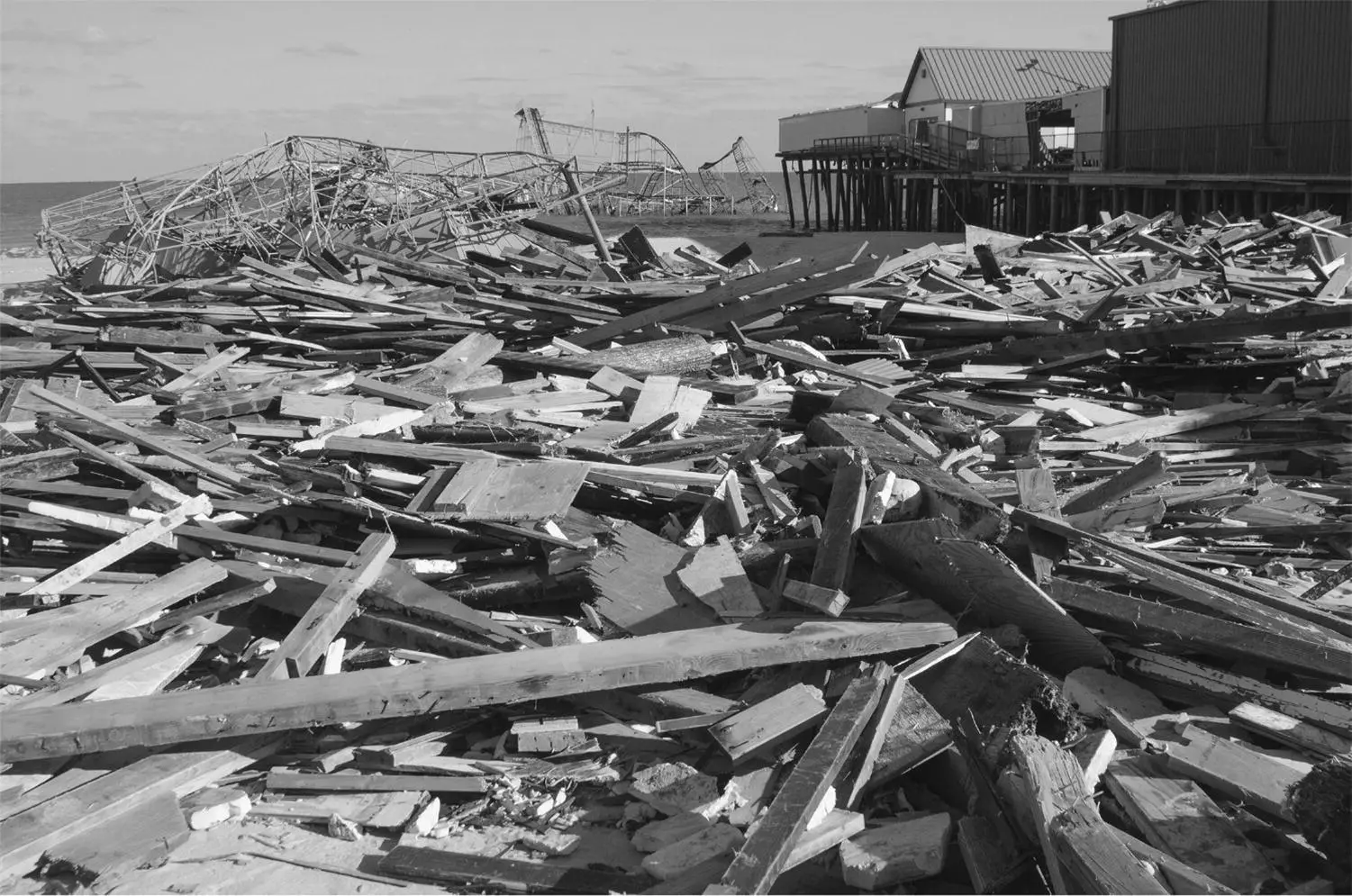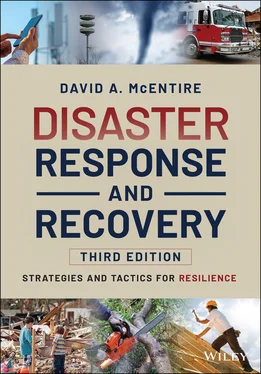David A. McEntire - Disaster Response and Recovery
Здесь есть возможность читать онлайн «David A. McEntire - Disaster Response and Recovery» — ознакомительный отрывок электронной книги совершенно бесплатно, а после прочтения отрывка купить полную версию. В некоторых случаях можно слушать аудио, скачать через торрент в формате fb2 и присутствует краткое содержание. Жанр: unrecognised, на английском языке. Описание произведения, (предисловие) а так же отзывы посетителей доступны на портале библиотеки ЛибКат.
- Название:Disaster Response and Recovery
- Автор:
- Жанр:
- Год:неизвестен
- ISBN:нет данных
- Рейтинг книги:5 / 5. Голосов: 1
-
Избранное:Добавить в избранное
- Отзывы:
-
Ваша оценка:
- 100
- 1
- 2
- 3
- 4
- 5
Disaster Response and Recovery: краткое содержание, описание и аннотация
Предлагаем к чтению аннотацию, описание, краткое содержание или предисловие (зависит от того, что написал сам автор книги «Disaster Response and Recovery»). Если вы не нашли необходимую информацию о книге — напишите в комментариях, мы постараемся отыскать её.
The new edition of the standard textbook in the field, updated with new studies and practical guidelines for reacting to the complexities of today’s disasters Disaster Response and Recovery: Strategies and Tactics for Resilience
Disaster Response and Recovery: Strategies and Tactics for Resilience, Third Edition
Disaster Response and Recovery — читать онлайн ознакомительный отрывок
Ниже представлен текст книги, разбитый по страницам. Система сохранения места последней прочитанной страницы, позволяет с удобством читать онлайн бесплатно книгу «Disaster Response and Recovery», без необходимости каждый раз заново искать на чём Вы остановились. Поставьте закладку, и сможете в любой момент перейти на страницу, на которой закончили чтение.
Интервал:
Закладка:
In order to meet these goals, Disaster Response and Recovery: Strategies and Tactics for Resilience will provide a comprehensive discussion about post‐disaster management issues and recommendations for their improvement. Chapter 2will help you as an emergency manager identify the actors involved in response and recovery operations. This includes government officials and agencies as well as corporations, nonprofit organizations, and even everyday people and the victims themselves. Chapter 3discusses human behavior in time of disaster. It dispels widely held myths and illustrates typical social reactions to collective stress. Chapter 4compares alternative theoretical stances regarding the management of disasters. It acknowledges the strengths and weaknesses of traditional and professional approaches. Chapter 5covers initial response measures, and it provides ideas on how to protect people through hazard detection, warning, evacuation, and sheltering. Chapter 6lists steps that can be taken to care for those who have been adversely affected by a disaster. This chapter shares information about search and rescue, emergency medical care, fatality management and psychological stress. Chapter 7shares recommendations on how to manage public relations and community resources. In particular, it discusses how you can effectively manage the media, donations and volunteers after a disaster. The transition from response to recovery is the subject of Chapter 8. It reviews functions such as damage assessment, disaster declarations and debris removal. In Chapter 9, disaster assistance programs are discussed along with ways to reduce vulnerability. This chapter provides information on recovery and how this post‐disaster activity must be linked to mitigation. The challenges of response and recovery are exposed in Chapter 10. This section will help you understand difficulties associated with communications, decision making, transportation, politics, special populations, legal issues and record keeping. Chapter 11points out tools that can be utilized and employed during response and recovery operations. These include technological equipment as well as organizational arrangements (e.g., incident command, emergency operation centers) that will improve coordination. Chapter 12covers lessons from prior disasters along with new threats and reasons for rising vulnerability. It attempts to help you think critically about how to deal with the disasters that will confront you and likewise consider the changes that must take place to improve the future of emergency management. Chapter 13illustrates ways to foster disaster resilience. This final chapter of the book discusses various aspects of disaster preparedness in addition to the importance of improvisation, spontaneous planning, leadership, and professionalism among emergency managers.
Before proceeding with the outlined direction of the book, the remainder of this initial chapter will provide additional information about the types of hazards and how they interact one with another. It also describes the impact of disasters and what you as an emergency manager can expect in their aftermath.
Self‐Check
What types of disruptive events can occur on a daily basis?
How are hazard events different from one another?
What is a disaster and what are their causes?
What is emergency management?
How is response defined?
What is disaster recovery?
1.2 Types of Hazards
As an emergency manager who may be involved in disaster response and recovery operations, you must understand the nature of hazards if you are to be successful with your assigned responsibilities. As discussed earlier, a hazardis a physical, technological, or anthropogenic agent such as an earthquake, a chemical release or a violent act. These hazards and their resulting disasters occur in the United States and around the world. Floods, tornadoes and earthquakes occur, leaving buildings in rubble and other property damage. Vehicles collide due to careless drivers or in conjunction with poor weather conditions. Trains derail due to a failure of the tracks or human error by the engineer. Petrochemical facilities contain large amounts of hazardous materials, which sometimes leads to an explosion at the industrial complex. Terrorists detonate improvised explosive devices, producing carnage and fear in their wake. Hazards occur for many different reasons. Some hazards occur naturally in the environment, while others are the result of human activity, neglect of safety precautions, careless mistakes or malicious intent.
1.2.1 Natural Hazards
Natural hazardsare those events originating from the physical environment, typically because of radiation from the sun, heat flow within the earth or the force of gravity. These natural hazards occur in and across three arenas of action (Mileti 1999):
The atmosphere (the air surrounding the earth that is made up of various gasses)
The hydrosphere (the earth’s water system)
The lithosphere (the earth’s crust)
Natural hazards are classified as having atmospheric, geologic, hydrologic, seismic, volcanic and wildfire origins. There are also other types of natural hazards that will be described in Sections 1.2.2– 1.2.7.

Figure 1‐2 Hurricane Sandy struck the northeast and destroyed this roller coaster on the boardwalk in Seaside Heights, NJ. Liz Roll/FEMA.Adapted from http://www.nhc.noaa.gov/aboutsshws.php
1.2.2 Atmospheric Hazards
An atmospheric hazardis a hazard agent that is produced in or by the earth’s atmosphere. A hurricane is one type of atmospheric hazard ( Figure 1‐2). Hurricanes begin as tropical depressions in the Atlantic Ocean and form as low‐pressure systems due to the warm water that fuels them. When wind speeds top 74 mph, such
tropical depressions become known hurricanes. In the Indian Ocean, these tempests are known as cyclones, and in the Pacific Ocean they are labeled typhoons. The eye or center of these storms is somewhat calm, but it is surrounded by circling cloud bands that produce rain in large amounts. Some hurricanes may have winds in excess of 100 or even 200 mph, and they may produce a storm surge that could reach up to 24 feet. The strength of a hurricane is described under the Saffir–Simpson scale. The Saffir–Simpson scaleis a descriptive tool to explain the magnitude of a hurricane in terms of wind and storm surge. It includes five categories. Category 1 is the weakest, while Category 5 is the strongest (see Table 1‐2).
This scale also estimates potential property damage. On the lower end of the scale, category 1 and 2 storms are smaller, but could nevertheless be dangerous and still require preparatory measures. Hurricanes reaching Category 3 and higher are considered major storm systems because of their potential for significant loss of life and damage. In the western North Pacific, the term “super typhoon” is used for tropical cyclones with sustained winds exceeding 150 mph.
In the Northern Hemisphere, hurricanes rotate in a counterclockwise direction and travel in a west–northwesterly direction. They frequently hit Atlantic states and those along the Gulf Coast. Florida is one of many states that frequently experiences hurricanes. For instance, Hurricane Andrew made landfall on August 24, 1992, and its strong winds devastated the Miami‐Dade area. This hurricane produced dozens of deaths and left thousands of people without power and shelter. Weak building codes and poor enforcement resulted in major structural collapses and a debris management nightmare. Hurricane Andrew’s impact on Florida was surpassed by the combined four hurricanes and one tropical storm that hit Florida in 2004. This was one of the worst hurricane seasons on record, but such storms have become even more problematic over the past few decades.
Читать дальшеИнтервал:
Закладка:
Похожие книги на «Disaster Response and Recovery»
Представляем Вашему вниманию похожие книги на «Disaster Response and Recovery» списком для выбора. Мы отобрали схожую по названию и смыслу литературу в надежде предоставить читателям больше вариантов отыскать новые, интересные, ещё непрочитанные произведения.
Обсуждение, отзывы о книге «Disaster Response and Recovery» и просто собственные мнения читателей. Оставьте ваши комментарии, напишите, что Вы думаете о произведении, его смысле или главных героях. Укажите что конкретно понравилось, а что нет, и почему Вы так считаете.












